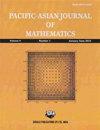寻找楔形简单复合体特征映射的算法策略
IF 0.7
3区 数学
Q2 MATHEMATICS
引用次数: 3
摘要
Choi和Park引入了谜题方法,将其作为在从给定的单纯复形K获得的楔形单纯复形K(J)上确定非奇异特征映射的有效方法。我们进一步研究了拼图方法的mod 2情况。我们首先用线性代数语言对其进行了完整的描述,这使我们能够开发出一种构造性的谜题算法。我们还分析了我们的算法,并将其性能与包括Garrison和Scott算法在内的其他已知算法进行了比较。本文章由计算机程序翻译,如有差异,请以英文原文为准。
An algorithmic strategy for finding characteristic maps over wedged simplicial complexes
. The puzzle method was introduced by Choi and Park as an effective method for finding non-singular characteristic maps over wedged simplicial complexes K ( J ) obtained from a given simplicial complex K . We study further the mod 2 case of the puzzle method. We firstly describe it completely in terms of linear algebraic language which allows us to develop a constructive puzzle algorithm. We also analyze our algorithm and compare its performances with other known algorithms including the Garrison and Scott algorithm.
求助全文
通过发布文献求助,成功后即可免费获取论文全文。
去求助
来源期刊
CiteScore
1.30
自引率
0.00%
发文量
93
审稿时长
4-8 weeks
期刊介绍:
Founded in 1951, PJM has published mathematics research for more than 60 years. PJM is run by mathematicians from the Pacific Rim. PJM aims to publish high-quality articles in all branches of mathematics, at low cost to libraries and individuals. The Pacific Journal of Mathematics is incorporated as a 501(c)(3) California nonprofit.

 求助内容:
求助内容: 应助结果提醒方式:
应助结果提醒方式:


